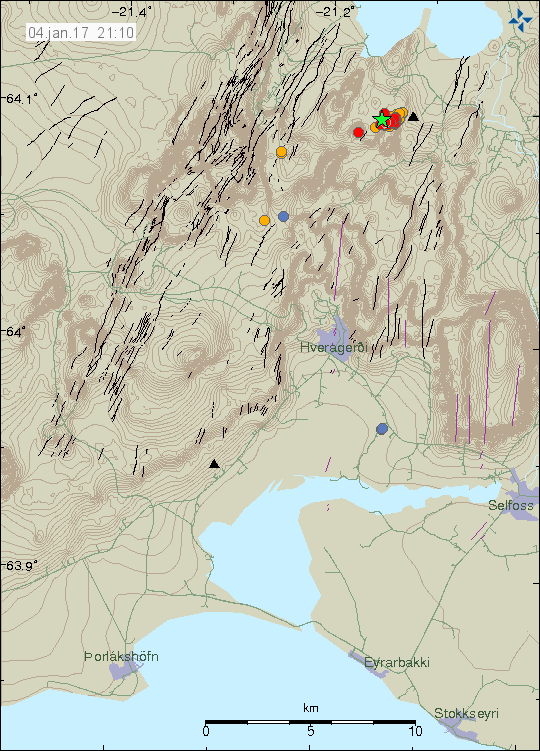On the 4th of January 2017 a earthquake swarm took place in Hengill volcano. Largest earthquake had the magnitude of 3,7 and the second earthquake had the magnitude of 2,8. The largest earthquakes where felt in Reykjavík, Hveragerði and Selfoss towns (mostly). In total of 150 earthquakes took place in this earthquake swarm.

The earthquake swarm in Hengill volcano from 4th of January 2017. Copyright of this image belongs to Icelandic Met Office.
This earthquake swarm was due to a process called rifting, this means that where the earthquake swarm is happening the ground is dropping and cracking at the same time. This over time forms a rift valley (like Þingvellir). The area from Hveravellir and south into the ocean of the Reykjanes ridge is all just one big rift valley. Far as I know a period of high earthquake activity can happen in this area, last time this happened sometimes around the middle of 19th century with possible activity sometimes in the 20th (early) century. Since then it has been mostly quiet.
In the year 1789 (source in Icelandic, 1973) the area around Þingvallavatn lake dropped around 63 cm (that estimate is not accurate and it is estimated that it was far more) in a earthquake swarm. When this is going to happen next time is impossible to know.
Donations
Please remember to support my work with donations. Thanks for the support. 🙂

Do you know if the past history of this kind of earthquake activity was anything like what happened in 1959 at Hebgen Lake in Montana?
I don’t know this area you name here, so that answer is no.
https://en.m.wikipedia.org/wiki/1959_Hebgen_Lake_earthquake
Jon, there is a rifting process going on here too, near Yellowstone. Land around the lake dropped in the earthquake, the lake tilted and landslides helped to form a new quake lake. The incident killed 28 people, mostly campers.
I don’t know if this part of Iceland near Hengill volcano is a popular place to camp during the summer months.
There is no evidence of a rift forming in the Hebgen Lake area. It was a normal fault (as opposed to thrust or stike-slip).
Not so simple, apparently.
https://gsa.confex.com/gsa/2009AM/finalprogram/abstract_164779.htm
But it’s too complex for superficial understanding.
Back in the fall, earthquakes occurred in this area and were reported as possibly being due to fluid reinjection at a geothermal plant. This process is similar to fracking.
http://grapevine.is/news/2016/09/19/last-weekends-earthquakes-possibly-caused-by-geothermal-power/
I don’t think that is happening in this area. At least I’ve not heard about it so far if it is happening.